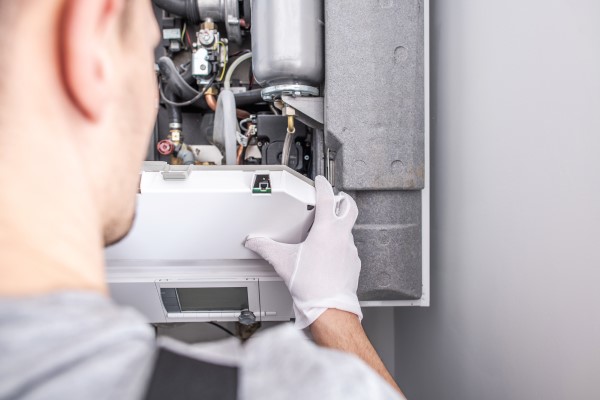5 Signs Your Furnace Needs Immediate Repair Before It Breaks Down This Winter
Call Us Anytime!
Watch for Signs of Emergency Furnace Repair
As temperatures dip and winter approaches, your furnace becomes a critical part of maintaining a comfortable and safe home. However, many homeowners fail to recognize early signs of furnace trouble, leading to unexpected breakdowns during the coldest months.
Ignoring these signs can not only leave you without heat but also result in costly emergency furnace repairs or even a full system replacement.
This guide highlights the five key warning signs that your furnace needs immediate attention, explains why addressing them early is crucial, and offers practical tips for maintaining your system to prevent future problems.




Strange Noises Coming from Your Furnace
A furnace in good working condition typically runs quietly, aside from a gentle hum or the occasional sound of air moving through the ducts. However, strange or loud noises often indicate underlying issues that require prompt attention. Here are some common sounds and what they might mean:
- Banging or Popping Sounds: These noises are often caused by expanding and contracting metal in the ductwork. However, they can also indicate a more serious issue, such as a cracked heat exchanger. This is a critical component that should be addressed immediately, as a damaged heat exchanger can leak carbon monoxide—a potentially deadly gas.
- Rattling or Vibrating: This can signal loose parts or debris within the furnace. If left unaddressed, these minor issues can escalate, causing damage to other components.
- Squealing or Screeching: High-pitched noises may be due to a worn or misaligned belt, issues with the blower motor, or a lack of lubrication in moving parts. These problems are relatively simple to fix if caught early.
- Clicking Sounds: A clicking noise when the furnace starts could point to issues with the ignition system or a malfunctioning relay. If the furnace struggles to ignite, it may stop working altogether, leaving your home cold.
Ignoring unusual noises can lead to further damage and expensive furnace repairs. Addressing them early ensures your furnace runs smoothly throughout the winter.
Uneven Heating Throughout Your Home
One of the primary jobs of your furnace is to distribute heat evenly throughout your home. If some rooms are warm while others remain cold, it’s a sign that your furnace isn’t functioning as it should. Common causes of uneven heating include:
- Clogged Filters: A dirty filter restricts airflow, preventing warm air from reaching all areas of your home. Regularly replacing or cleaning filters can help resolve this issue.
- Leaky Ductwork: Holes, gaps, or poorly sealed ducts can cause warm air to escape before it reaches your living spaces. Professional duct sealing can improve heat distribution and efficiency.
- Blower Motor Issues: A failing blower motor struggles to push air through the duct system, resulting in uneven heating.
- Poor Thermostat Placement or Calibration: If your thermostat is located in an area that doesn’t accurately reflect your home’s average temperature, it may cause inconsistent heating. A professional can recalibrate or relocate your thermostat to ensure proper functionality.
Addressing uneven heating not only improves comfort but also reduces strain on your furnace, helping it operate more efficiently.
Constant Cycling (Turning On and Off)
Furnaces are designed to operate in cycles, turning on when the temperature drops below the set point and turning off once the desired temperature is reached. If your furnace is constantly turning on and off—known as short cycling—it’s a clear indication of a problem. Common causes include:
- Thermostat Issues: A malfunctioning thermostat may cause the furnace to turn on and off too frequently. Recalibrating or replacing the thermostat can resolve this issue.
- Clogged or Dirty Filters: Restricted airflow can cause the furnace to overheat, triggering its safety mechanisms to shut it down prematurely.
- Improper Furnace Sizing: If your furnace is too large for your home, it may heat the space too quickly, causing frequent cycling. This not only wastes energy but also shortens the lifespan of the system.
Short cycling increases wear and tear on your furnace, leading to higher energy bills and a greater likelihood of breakdowns. A professional inspection can identify the root cause and restore normal operation.
Rising Energy Bills
If you notice a sudden spike in your energy bills during the fall or winter, it could be a sign that your furnace isn’t operating efficiently. Inefficiencies can result from:
- Dirty Burners: Accumulated dirt or debris on the burners can reduce the furnace’s ability to generate heat efficiently.
- Leaky Ductwork: Heat loss through leaks in the ducts forces the furnace to work harder to maintain the desired temperature.
- Aging Components: Over time, parts like the blower motor or ignition system may wear out, consuming more energy to perform their functions.
- Lack of Maintenance: A neglected furnace is more likely to operate inefficiently. Regular maintenance, such as cleaning and tune-ups, helps maintain optimal performance.
Higher energy bills are a red flag that your furnace is overworking to compensate for inefficiencies. Early furnace repairs and maintenance can help restore efficiency and reduce costs.
Strange or Unpleasant Odors
Your furnace should not emit unusual or unpleasant smells during operation. If you notice any of the following odors, it’s important to take action immediately:
- Burning Smell: A burning odor when the furnace is first turned on for the season is normal as dust burns off the components. However, if the smell persists, it could indicate overheating or electrical issues.
- Rotten Egg Smell: This is a serious warning sign of a gas leak. Natural gas is odorized with a sulfur-like scent to make leaks detectable. If you smell rotten eggs, turn off your furnace, evacuate your home, and contact a professional immediately.
- Musty Smell: A musty or moldy odor could indicate mold growth in the ductwork or furnace, which can negatively impact indoor air quality.
Addressing strange odors promptly ensures the safety and efficiency of your heating system.
Why Early Furnace Repairs Are Crucial
Delaying furnace repairs can lead to a cascade of issues that are more costly and inconvenient to resolve. Here’s why addressing problems early is essential:
- Prevents Emergency Breakdowns: Small issues can escalate, causing your furnace to fail during peak winter demand when HVAC professionals are busiest.
- Reduces Repair Costs: Addressing minor problems early is often less expensive than dealing with major repairs or system replacements.
- Extends Furnace Lifespan: Regular maintenance and timely repairs reduce wear and tear, helping your furnace last longer.
- Ensures Safety: Malfunctions like gas leaks or cracked heat exchangers can pose serious health risks. Early detection and repair protect your family from potential harm.
Tips for Maintaining Your Furnace
In addition to recognizing the warning signs of furnace trouble, proactive maintenance can help you avoid many issues. Here’s how to keep your system in top shape:
- Schedule Annual Maintenance: Have your furnace professionally inspected and serviced each fall to ensure it’s ready for the winter.
- Change Filters Regularly: Replace filters every 1–3 months during the heating season to maintain good airflow and reduce strain on the system.
- Seal Leaks and Insulate: Ensure your home is well-insulated and that all ducts are properly sealed to prevent heat loss.
- Use a Programmable Thermostat: Optimize your furnace’s performance by programming temperature settings based on your schedule.
- Inspect Ducts and Vents: Check for blockages, leaks, or damage that could impact airflow and efficiency.
How to Prepare for a Furnace Repair Visit
If you notice any of the five warning signs mentioned in the blog, scheduling a repair is the next step. Preparing for the technician’s visit ensures a smooth and efficient process. Here’s how to get ready:
- Gather Information: Note the symptoms, such as unusual noises, uneven heating, or persistent cycling. Provide details like when the issue started and how often it occurs.
- Clear the Area: Remove any obstructions around the furnace to give the technician easy access to the unit.
- Check the Filter: Replace or clean the filter if you haven’t done so recently. A clean filter ensures the technician can accurately diagnose other issues.
- Review Your Warranty: Familiarize yourself with your furnace’s warranty terms to determine if the furnace repair is covered.
- Ask Questions: Prepare a list of questions to ask the technician about the repair, future maintenance needs, and ways to improve system efficiency.
Taking these steps ensures the repair process is quick and effective, minimizing downtime and getting your furnace back to optimal performance.
Understanding the Costs of Ignoring Furnace Issues
Delaying furnace repairs might seem like a way to save money in the short term, but it can lead to far greater expenses down the line. Understanding the true costs of ignoring furnace warning signs can help you prioritize repairs and maintenance before issues escalate:
Escalating Repair Costs
Small problems, such as a clogged filter or a loose belt, are typically inexpensive to fix if caught early. However, ignoring these minor issues can lead to major component failures. For example:
- A dirty burner can cause uneven heating, eventually leading to a cracked heat exchanger, which is one of the costliest furnace repairs.
- Ignition problems, if left unaddressed, may require an entire system replacement rather than a simple fix.
Energy Inefficiency Adds Up
When your furnace isn’t operating at peak efficiency, it consumes more energy to maintain the desired temperature. Over an entire winter season, these inefficiencies can result in significantly higher utility bills—often much more than the cost of addressing the issue promptly.
Decreased Home Comfort
An inefficient furnace often results in inconsistent heating, leaving some rooms too cold while others may become overheated. This can disrupt your family’s comfort and force the system to work harder to compensate, leading to accelerated wear and tear.
Safety Hazards
Certain furnace issues, such as a cracked heat exchanger or a gas leak, pose serious risks to your family’s safety. Carbon monoxide poisoning or fire hazards are potential outcomes of neglecting these problems. Addressing these issues early protects your loved ones and ensures peace of mind.
Premature Furnace Replacement
Failing to address repair needs can shorten your furnace’s lifespan significantly. A system that could have lasted 15–20 years may need replacement in just 10–12 years if it’s consistently overworked. The cost of premature replacement far outweighs the expense of regular maintenance and timely repairs.
Get Furnace Repair Now
Your furnace is essential for keeping your home warm and comfortable during the winter. By recognizing warning signs such as strange noises, uneven heating, short cycling, rising energy bills, and unusual odors, you can address problems early and avoid costly breakdowns. Regular maintenance and timely furnace repairs not only improve efficiency but also extend the lifespan of your heating system.
Take proactive steps this fall to ensure your furnace is ready for the colder months. Schedule an inspection with a professional HVAC technician and address any issues promptly to keep your home cozy and stress-free all winter long.

